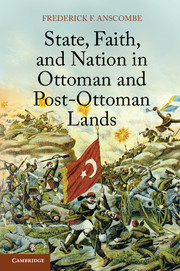Book contents
- Frontmatter
- Dedication
- Contents
- List of Maps and Images
- Acknowledgments
- Transliteration and Abbreviations
- Maps
- Introduction
- Part I The Ottoman Empire
- 1 State, Faith, Nation, and the Ottoman Empire
- 2 The Premodern Islamic State and Military Modernization
- 3 The Breaking of the Premodern Islamic State
- 4 The Reconstructed Muslim State
- 5 End of Empire
- Part II From Ottoman to Post-Ottoman States
- Part III Contemporary Post-Ottoman States
- Conclusion State, Faith, and Nation
- Bibliography
- Index
- References
2 - The Premodern Islamic State and Military Modernization
Published online by Cambridge University Press: 05 June 2014
- Frontmatter
- Dedication
- Contents
- List of Maps and Images
- Acknowledgments
- Transliteration and Abbreviations
- Maps
- Introduction
- Part I The Ottoman Empire
- 1 State, Faith, Nation, and the Ottoman Empire
- 2 The Premodern Islamic State and Military Modernization
- 3 The Breaking of the Premodern Islamic State
- 4 The Reconstructed Muslim State
- 5 End of Empire
- Part II From Ottoman to Post-Ottoman States
- Part III Contemporary Post-Ottoman States
- Conclusion State, Faith, and Nation
- Bibliography
- Index
- References
Summary
If the last, long century of the Ottoman empire’s life was remarkable for its turbulence, there was no more critical period prior to the catastrophic 1911–22 years than the decades from 1768 to 1839. It determined in stark terms the primary goal that would challenge state and society for the remainder of the empire’s existence: finding sustainable means to stave off the existential threat posed by a militarily dominant Christian Europe. Much of the turmoil seen in the reign of Sultan Selim III (1789–1807), culminating in his overthrow by a rebellion in Istanbul, was created by dissension over whether the ends justified the means that he chose. Following defeats by Russia and the Habsburgs, Selim’s regime tried to unravel the secrets of their military supremacy and to copy the key elements, but the challenge of identifying such secrets proved impossible to solve. The regime fell because it lost the support of those who felt that preservation of the Abode of Islam would only be possible if the implicit and explicit understandings that bound state and society together under the old system were upheld, and the principles that made the empire the Abode of Islam were respected.
Much of that opposition resulted from the impression that the sultan was giving greater attention to adaptation of Christian ways than he had to supporting the Ottoman army while it suffered in trying to save the empire from the Russians and Habsburgs. Anger was magnified by Istanbul’s perceived placement of blame for failures of the political-military system upon those who had shouldered the burden of defense. Ottoman defeats did not result from corruption but from basic lack of military competencies that Christian European armies had acquired by the end of the eighteenth century, courtesy of recent decades’ experience in butchering each other and the rise of absolutist governments capable of exploiting resources relatively intensively. Christian armies were better supplied, organized, commanded, trained, and disciplined. Above all, they were bigger and had better artillery, and more of it. Insofar as responsibility for not keeping pace fell on the Ottoman system, the fault lay in the slighting of military preparedness that became Istanbul’s habit in the eighteenth century.
- Type
- Chapter
- Information
- Publisher: Cambridge University PressPrint publication year: 2014



